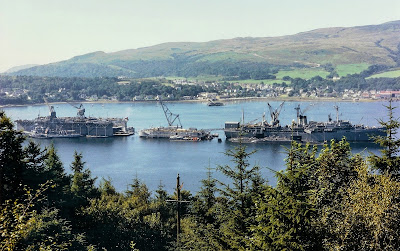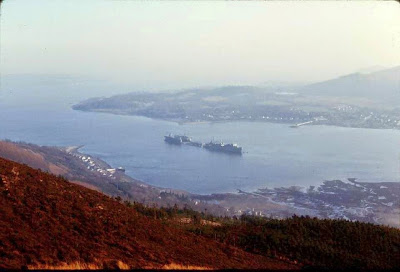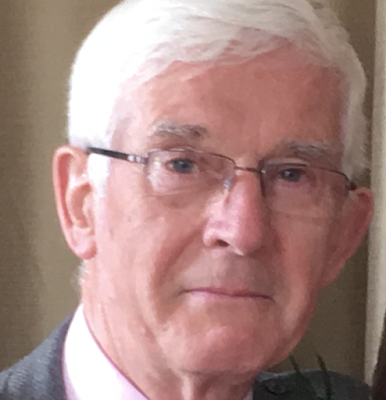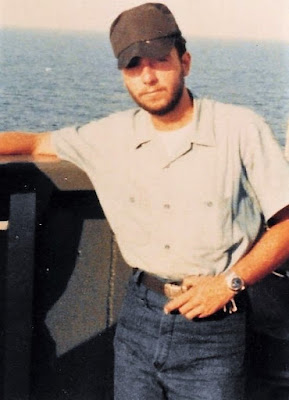The Journal of Counterterrorism & Homeland Security International published my Q&A with D.G. Mackay, the author of Bubbleheads, SEALs and Wizards: America’s Scottish Bastion in the Cold War.
You can read the piece below or the below text:
D.G. Mackay is a British military historian and the author of “Bubbleheads, SEALs and Wizards: America’s Scottish Bastion in the Cold War.” (Whittles Publishing).
The book covers the period in the Cold War between 1961 and 1992
when Holy Loch, Scotland was the site of the United States Navy’s nuclear
submarine base, the home base of Submarine Squadron (SUBRON) 14. In addition to
the submarine base, the U.S. military also stationed Navy SEALs and signals
intelligence technicians in Scotland to deter the nuclear threat from the
Soviet Union.
D.G. Mackay served as an officer in the Parachute Regiment from 1970 to 1987. Retiring as a Lt Col., D.G. Mackay served three tours in Northern Ireland, two tours in UN Cyprus, the Middle East, and various NATO countries including USA, Berlin, Germany, and Nigeria.
Mackay holds two degrees from the University of Glasgow and one from Leicester University. He was also the American Modern History tutor at Glasgow and academic researcher at Stirling University.
D.G. Mackay was interviewed by Paul Davis.
Writer’s Note:
Mr. Mackay interviewed me for the book, as I served two years (1974-1975) as an
enlisted sailor aboard the U.S. Navy tugboat USS Saugus, YTB 780, at the U.S.
nuclear submarine base at Holy Loch, Scotland.
In one passage, he confuses me with another former sailor,
stating that I served as a mess cook on the submarine tender. Mess cooking was a
rite of passage for tender sailors, but not for tugboat sailors like me. But my
other comments in the book about tugboat and submarine operations are
accurate.
IACSP: How would you
describe your book and why did you write it?
Mackay: The book is a street-level account of the American military presence
in Scotland during the Cold War. It demonstrates that Scotland was a vital
location for both the United States and NATO during this period. History is
made by leaders but is carried out by people further down the chain of command.
I was one of these, a UK Cold War warrior and can vouch for the untold hours of
hard work involved. This detailed and thorough work ensured that NATO was
successful in the struggle. Their work ethic and pride in their work is the
underpinning theme of the book. That is why I chose to write the book – the
so-called ‘little people’ tend to be ignored, while lavish attention is poured on to national leaders. The book is a memorial to the day-to-day
heroes who won the Cold War.
IACSP: How did you
research the book? Who were your principal sources?
Mackay: Researching
the book was problematic as it was mainly done during the pandemic and all
archives were closed. However, I was able to dig deep into the internet and
unearth many declassified documents. In particular, I worked closely with many
veterans’ websites and ended up interviewing more than 150 different people who
had been closely involved in this great and exciting enterprise. Most of these
interviews were conducted online but some were by telephone, and a few were
face-to-face. It was an invigorating experience.
IACSP: Would you
describe the how and why the Americans moved their submarine fleet into Holy
Loch?
Mackay: How. A small
advance part of US Navy personnel came to Dunoon early in 1961 and liaised with
the Royal Navy and local police. In April, the tender ship, USS Proteus,
arrived in Holy Loch to be met by a noisy, but peaceful demonstration. Some
protesters in canoes attempted to board the vessel but these were chased away,
and US Navy sailors were unmolested when they later made their way through the
crowd. One of the protesters was a local lad, son of the Dunoon police
sergeant; his name was George Robertson and ironically, he later became NATO’s
Secretary-General.
Why. The Holy
Loch location was the result of an agreement between the UK and US governments
which traded this ideal location for American nuclear submarines against
British involvement in building their own nuclear-armed submarines with
American technical input. The McMahon Act in the United States had forbidden this
kind of liaison but the Camp David Agreement in 1959 between Eisenhower and MacMillan overcame it.
IACSP: How would you
describe the floating base anchored in the center of the
Loch?
Mackay: It was a
fully functional floating dockyard with more than 3,000 employees, adjacent to
the River Clyde which was one of the world’s most important ship-building
centers in those days. There was a tender ship, which was a fully fitted
shipyard and carried out all maintenance and simple repair tasks to the
submarines. A huge floating dock would raise the submarines to enable the work
to be done. Various floating barges accommodated the workforce and lots of
small Navy vessels crisscrossed the loch in support.
IACSP: How did the
Scots initially react to the new submarine base? Did the public view of the
Americans change over time?
Mackay: Most Scots
were unaffected by this dramatic influx of American military activity. There
were some anti-nuclear, anti-American demonstrations but these were principally
by outsiders who did not come from Scotland. They quickly died down and any
local demonstrations thereafter were small and good natured. Scots regarded the
Americans as interesting people and our two nations have had a long and close
relationship; many American Presidents have Scottish roots and Scots signed the
Declaration of Independence. We regarded the American military as cousins and
the on-site relationship was normally excellent at all the US bases.
IACSP: Did the
British military and security services work closely with the Americans in
countering the Soviet Bear?
Mackay: Part of my
research covered the activities of the security services of both the United
States and Great Britain. Glasgow, Edinburgh and Aberdeen were already Soviet
nuclear targets because of their industrial base and transport infrastructure.
In the book, my CIA and UK security services contacts outline the vigorous
steps which were taken at the time and emphasize the joint nature of this
delicate mission. They reveal that this was always a joint venture, with the UK
security services taking the lead as home nation.
IACSP: You also
write about the American “Wizards.” How would you describe them?
Mackay: The Wizards were the US Navy, USAF and USMC radio technicians who
manned the radio spy stations at Kirknewton, Edzell and Thurso. I doubt if
anybody in Scotland was aware of their real purpose at the time and there is
certainly zero knowledge about it even at this later date. They were part of
various US-worldwide radio intercept operations which had a huge effect on the
Cold War. In particular, they were vital sources of information during the
Cuban Missile Crisis in 1962. The UK also provided military and security
services personnel for this task which was directed by the NSA and coordinated
by GCHQ. The secrecy imposed at each location was excellent and local rumors
were always fanciful but wide of the mark. And don’t forget that Evanton
airfield was one of the major launch sites for Ike’s spy balloons in 1955 – an
incident almost totally forgotten in that locality.
IACSP: And you write
about U.S. Navy SEALs in Scotland. What were they doing?
Mackay: Scotland’s
geography is superb for Special Forces training as I can vouch. This was
obviously a bonus for the SEALs who were based at Machrihanish airfield in a
forward-deployed base, similar to the concept of the submarine base at Holy
Loch. Their operational zone was in Norway and therefore only a few hours from
Scotland. They constantly trained in the locality, often in the nearby Atlantic
Ocean, and were so professional that these exploits were seldom witnessed by
the locals.
IACSP: Was the U.S. Navy at Holy Loch and other American military units in the U.K. a force for good for both the U.S. and the U.K.?
Mackay: I Would not use the word ‘good’ to describe this situation. It was a straightforward fact that this arrangement brought benefits to both countries. The US military presence in Scotland during the Cold War was definitely useful to the UK to be closely involved in the delivery of US military strategy as it increased the close liaison between both nations. The US certainly benefitted from the arrangement as it brought strategic and operational benefits, as well as providing an offshore first strike target for the Soviets. JFK was able to send his top adviser unnoticed to Holy Loch during the Cuban Missile Crisis to assess the battle readiness of the nuclear submarine squadron. His Doomsday orders would have been transmitted through the radio station at Thurso, while the submarine’s navigation accuracy was ensured from Scatsta in the Shetland Isles. For the UK, there were the undoubted benefits of American military nuclear technology.
IACSP: Would you please also describe how Holy Loch was a hotbed of espionage?
Mackay: Holy Loch was the center of the latest military technology - nuclear-powered, nuclear missile armed submarines. The Soviets desperately needed this technology as their submarines and missiles were basic and unreliable. At an early stage, the squadron security investigator requested a special order of surveillance equipment to monitor leisure areas frequented by the sailors, such was the concern about the possible presence of Soviet agents. The KGB mounted a serious intelligence-collecting operation. They purchased a small hotel in Dunoon, installed an East German agent and lured in several US Navy personnel and a local man. All were caught and jailed except the local who appeared to have been working for the UK security services.
IACSP: You mention other espionage stories in your book.
Mackay: In another incident in the book, a taxi driver began to ask too many detailed questions and a sailor reported this to the squadron security team. Probably the most hilarious example was when several KGB personnel boarded a pleasure steamer and took photos of the base with long-lens cameras. When they disembarked in Glasgow they split up and disappeared from public view. An international trade union conference in Dunoon was flooded with KGB, Stasi, Czech and Polish agents posing as delegates and the squadron commander had to put the hotel out of bounds to US Navy personnel.
Then, of course, there was the notorious spy John Walker who served aboard a submarine in Holy Loch.
IACSP: Thanks for speaking to us.













No comments:
Post a Comment